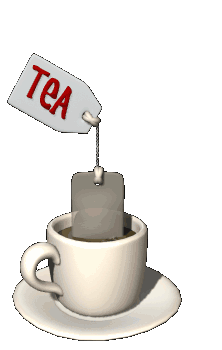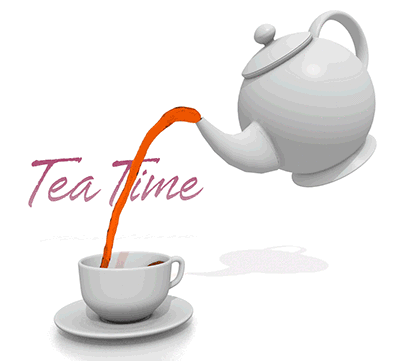


Tea" became very important for people in the UK. It started in 19th century, when tea was delivered to the UK from China by sea on very fast boats. English boats came first and British merchants could sell tea at the highest price and get huge profit. It gave lots of money to the tea merchants and to the British economy. It was a good motive to develop merchant fleet and merchant ship building. Strong and fast ships were needed and consequently marinae engineering had to develop faster in order to meet the needs of the merchants. As a result such ships as the Cutty Sark appeared.
 |  |
|---|---|
 |  |
 |  |

Probably the most significant change that tea brought to the British is connected with the health of the nation. Waterborne pathogens have always been high on the lists of major causes of sickness and death; in many places today they continue to be. When populations began to concentrate themselves in cities, contaminated water became a much greater problem. Several hundred years ago, people did not know that many of their illnesses were due to organisms in their water. However, by boiling water to make tea, they were killing many harmful waterborne microorganisms without even knowing it. Although they did not know why, many were aware that drinking tea was safer than drinking water.
Tea first became labeled as a medical drink in 1641 by Dr. Nikolas Dirx, who wrote under the pseudonym “Nicolas Tulp” and was a celebrated Dutch physician. Tulp praised tea in his book, Observationes Medicae, claiming that “nothing is comparable to this plant” and that those who use it are “exempt from all maladies and reach an extreme old age.”He goes into detail on the specific merits of tea, such as curing “headaches, colds, ophthalmia, catarrh, asthma, sluggishness of the stomach, and intestinal troubles.”
It is important to note that Tulp was also a director of the Dutch East India Company, so his praise of tea was likely a marketing tactics. Thomas Garway, the first English shopkeeper to sell tea, published a broadsheet in 1660 titled “An Exact Description of the Growth, Quality, and Vertues of the Leaf TEA” which also praised tea’s medical benefits. Garway claims that “the Drink is declared to be most wholesome, preserving in perfect health until extreme Old Age,” as well as “maketh the body active and lusty,” “helpeth the Headache,” “taketh away the difficulty of breathing,” “strengtheneth the Memory,” and “expelleth infection”. There were many more published works on the health benefits of tea, including those by Hartlib in 1657, Bontekoe in 1678, Povey in 1686, and Tryon in the 1690s. Even John Locke, the famous English philosopher, developed a fondness for tea after spending time with Dutch medical men in the 1680s. Ellis, Coulton, and Mauger refer to these men as “virtuosi”: scientists, philosophers, and doctors who first took an interest in tea and contributed to its early popularity as a pharmaceutical. But, such as with the case of Tulp, some of these men may have been influenced by Indies companies and merchants who wished to create a market for tea. Nevertheless, there is little doubt that these writings about the so-called health benefits of tea contributed to rise in popularity of tea in England.








The proliferation of works on the health benefits of tea happened to come at a time when people in the upper classes of English society began to take an interest in their health, which ties into the second factor that gave rise to tea’s popularity. As most historians will say, Princess Catherine of Braganza, the Portuguese princess who married King Charles II in 1662, introduced tea to the aristocratic class and made it fashionable among the ladies of the court. According to Ellis, Coulton, Maugher, “tea was six to ten times more expensive than coffee” in the 1660s, making it an extremely expensive and luxurious commodity. Tea’s association with luxury was perhaps why it became so popular among the elite.
There can be given some more examples from the history of the country when tea helped to cope with some crisis situations. After the Second World War many men were killed, towns were destroyed and it was very difficult for women to find the jobs and get the money to buy food. Many women had to find the way to start their own little business. They could open little tea rooms in their houses and to serve tea, little cakes and bread there. It helped them to get some money. Many tea rooms opened in every little village and town and became very popular for British people.
"Tea" and "Invitation for Tea" became very important for social life of people and especially for women. In the 19th century women could not go to the Clubs or Pubs, which were very popular for men, but women wanted to be social, see each other, communicate to each other. They started to invite each other for Tea or to meet in the tea rooms for tea to see each other, to meet and to talk to each other. It became very important for their lives and we keep this tradition and meeting for tea is very it is very popular now!
Nowadays tea drinking became a social event. People started gathering not just to drink a cup of well-brewed tea but to chat, small talk. So as a result certain etiquette and traditions developed and flourished. There appeared different kinds of tea houses/rooms, from quite common where one could buy a cup of tea for a reasonable price to some posh restaurant based tea rooms, where tea was served in exquisite way. Practically the same tea which was served in common tea rooms was served in posh hotels to the sound of live orchestras. Albert Hall, the famous London concert hall for example, organizes weekend morning tea to the music of some young singers, who later may be part of an evening performance.



